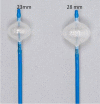The Use of Cryoballoon Ablation in Atrial Fibrillation: Simplifying Pulmonary Vein Isolation?
- PMID: 28496678
- PMCID: PMC5398820
- DOI: 10.4022/jafib.294
The Use of Cryoballoon Ablation in Atrial Fibrillation: Simplifying Pulmonary Vein Isolation?
Abstract
Atrial fibrillation (AF) is certainly the most common arrhythmia encountered in clinical practice, reaching epidemic proportions in occidental society. Nowadays, transcatheter ablation using radiofrequency (RF) has become a popular technique in the treatment of drug-resistant AF. Since ectopic beats originating from the pulmonary veins (PVs) have been shown to be the main trigger initiating AF, electrical isolation of these venous structures has become the goal when performing this procedure.
Figures








Similar articles
-
Cryoballoon versus radiofrequency for pulmonary vein re-isolation after a failed initial ablation procedure in patients with paroxysmal atrial fibrillation.J Cardiovasc Electrophysiol. 2013 Mar;24(3):274-9. doi: 10.1111/jce.12038. Epub 2012 Dec 4. J Cardiovasc Electrophysiol. 2013. PMID: 23210695 Clinical Trial.
-
Arrhythmia-free survival and pulmonary vein reconnection patterns after second-generation cryoballoon and contact-force radiofrequency pulmonary vein isolation.Clin Res Cardiol. 2018 Jun;107(6):498-506. doi: 10.1007/s00392-018-1211-9. Epub 2018 Feb 6. Clin Res Cardiol. 2018. PMID: 29411114 Clinical Trial.
-
Second-generation cryoballoon ablation for recurrent atrial fibrillation after an index procedure with radiofrequency versus cryo: Different pulmonary vein reconnection patterns but similar long-term outcome-Results of a multicenter analysis.J Cardiovasc Electrophysiol. 2019 Jul;30(7):1005-1012. doi: 10.1111/jce.13938. Epub 2019 Apr 15. J Cardiovasc Electrophysiol. 2019. PMID: 30938917
-
The Hot and the Cold: Radiofrequency Versus Cryoballoon Ablation for Atrial Fibrillation.Curr Cardiol Rep. 2015 Sep;17(9):631. doi: 10.1007/s11886-015-0631-7. Curr Cardiol Rep. 2015. PMID: 26266757 Review.
-
Surgical Ablation of Atrial Fibrillation: is Electrical Isolation of the Pulmonary Veins a Must?J Atr Fibrillation. 2016 Jun 30;9(1):1426. doi: 10.4022/jafib.1426. eCollection 2016 Jun-Jul. J Atr Fibrillation. 2016. PMID: 27909520 Free PMC article. Review.
Cited by
-
Morphological and morphometric study of pulmonary vein anatomy in relation to cardiac invasive and electrophysiological procedures.Anat Cell Biol. 2023 Dec 31;56(4):428-434. doi: 10.5115/acb.23.141. Epub 2023 Nov 10. Anat Cell Biol. 2023. PMID: 37946563 Free PMC article.
References
-
- Natale Andrea, Raviele Antonio, Arentz Thomas, Calkins Hugh, Chen Shih-Ann, Haïssaguerre Michel, Hindricks Gerhard, Ho Yen, Kuck Karl Heinz, Marchlinski Francis, Napolitano Carlo, Packer Douglas, Pappone Carlo, Prystowsky Eric N, Schilling Richard, Shah Dipen, Themistoclakis Sakis, Verma Atul. Venice Chart international consensus document on atrial fibrillation ablation. J. Cardiovasc. Electrophysiol. 2007 May;18 (5):560–80. - PubMed
-
- Haïssaguerre M, Jaïs P, Shah D C, Takahashi A, Hocini M, Quiniou G, Garrigue S, Le Mouroux A, Le Métayer P, Clémenty J. Spontaneous initiation of atrial fibrillation by ectopic beats originating in the pulmonary veins. N. Engl. J. Med. 1998 Sep 03;339 (10):659–66. - PubMed
-
- Ouyang Feifan, Bänsch Dietmar, Ernst Sabine, Schaumann Anselm, Hachiya Hitoshi, Chen Minglong, Chun Julian, Falk Peter, Khanedani Afsaneh, Antz Matthias, Kuck Karl-Heinz. Complete isolation of left atrium surrounding the pulmonary veins: new insights from the double-Lasso technique in paroxysmal atrial fibrillation. Circulation. 2004 Oct 12;110 (15):2090–6. - PubMed
-
- Cappato Riccardo, Calkins Hugh, Chen Shih-Ann, Davies Wyn, Iesaka Yoshito, Kalman Jonathan, Kim You-Ho, Klein George, Natale Andrea, Packer Douglas, Skanes Allan, Ambrogi Federico, Biganzoli Elia. Updated worldwide survey on the methods, efficacy, and safety of catheter ablation for human atrial fibrillation. Circ Arrhythm Electrophysiol. 2010 Feb;3 (1):32–8. - PubMed
-
- Neumann Thomas, Vogt Jürgen, Schumacher Burghard, Dorszewski Anja, Kuniss Malte, Neuser Hans, Kurzidim Klaus, Berkowitsch Alexander, Koller Marcus, Heintze Johannes, Scholz Ursula, Wetzel Ulrike, Schneider Michael A E, Horstkotte Dieter, Hamm Christian W, Pitschner Heinz-Friedrich. Circumferential pulmonary vein isolation with the cryoballoon technique results from a prospective 3-center study. J. Am. Coll. Cardiol. 2008 Jul 22;52 (4):273–8. - PubMed
Publication types
LinkOut - more resources
Full Text Sources
Research Materials
